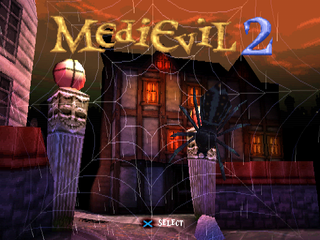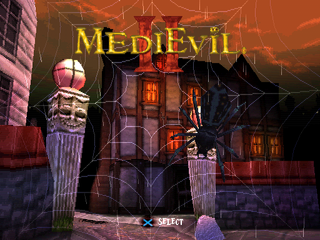MediEvil II
| MediEvil II |
|---|
|
Also known as: MediEvil 2 (EU)
|
| This needs some investigation. Discuss ideas and findings on the talk page. Specifically: Ripping the subtitle information shows a few interesting leads, like pre-release names (Wulfrum Hall was called Vampire Mansions, Kiya was called Princess) and references to what seems like a debug menu |
MediEvil II is, as you might have guessed, the sequel to MediEvil. Daniel is back from the dead once again, but this time in a new era and with a new voice.
Sub-Page
| Prerelease Info |
Build Info
Located at the start of PROJFILE.MWD.
| USA |
|---|
Creation Date: Thursday, 30th March 2000 Creation Time: 19:07:40 Build 1.1Q USA Master Build 68708 |
Unused Speech
There are several speeches from Winston the Help Ghost that are never used in the final game.
This could be a good time to save.
Winston uses the same line for every mid-level checkpoint. Given his wavering voice, this might have been used right before the final boss fights.
You ought to save your game before you carry on, you never know what's around the corner.
Same as above, but lacks any obvious hints as to its intended location.
Good luck Dan.
This line exists in the subtitles data, and is linked to the above line, but goes unvoiced.
You can put your head back on, through the inventory or the L2 + triangle shortcut, when the light comes on.
Winston explains the head mechanics in situational speeches, like when Dan first gets his head stolen. This speech is unusually brief, considering that most mechanics are explained all at once, and is made obsolete by Greenwich Observatory's opening speech.
When the light comes on you can move your head between body and hand.
This line has the same issues as the above head line, and is made obsolete by Wulfrum Hall's opening speech.
I'm Winston the Help Ghost, your source of information in this game. I can tell you some great tips if you want? Do you know that you can jump by pressing the circle button on your Joypad at anytime? While you're jumping you can still continue to fight. See you later Dan!
This was never narrated, and exists only in the subtitles. It was seemingly replaced by his current intro.
Regional Differences
| Europe | US |
|---|---|
 |
 |
The logo was changed in the North American version. It now resembles the logo from the original game, just with the "II" added.
Anti-Piracy
Some PlayStation games released after 1998 contain some form of copy protection/anti-piracy measures, in order to curb the use of modchips and illegal copies that were instrumental in the spread of piracy on the system. Sony developed two systems for protecting games. The first one is Anti-Modchip, and the other is LibCrypt.
Anti-Modchip protection works on the hardware level and pretty straight-forwardly. As earlier modchips were active by default through constant injection of region data during bootup, all that it needs for the game to detect one is for the game to return data from a modchip when requested. If it returns data, the game shows an error message screen telling the user that the console may have been modified (i.e. has a modchip). The moment it shows the screen varies from title to title, but it usually happens shortly after booting a game. Early versions of this protection only had a sign with a red hand, hence the Japanese naming for this copy protection: "Red Hand Protect" (レッドハンドプロテクト, reddo hando purotekuto) or RHP for short. Later versions have a "No go" sign with a message in either Japanese or English.
LibCrypt functions on the software level in two ways: by detecting a modchip upon bootup of the game and by detecting an illegal copy through a 16-bit key located in the subchannel data of the disc. The first check is to see whether or not a modchip is installed on the system. As earlier modchips are active by default, all that is necessary to detect one is for the program to return data from a modchip. If it detects it, the game crashes immediately. This was mitigated by pirates with so-called "stealth" modchips, which turn off immediately when loading disc region data during bootup. However, the second check now comes into play. The second part functions as a part of the game. It decrypts the 16-bit LibCrypt data key stored in the subchannel of the disc and stores it in the coprocessor of the system. If the data is incorrect, the game implements its anti-piracy measures. As most CD burners cannot properly replicate subchannel data on the disc, a pirated copy, whether burned directly to another disc or as a disc image, trips the anti-piracy measure by default.
A modded system allows for a backup, a pirated copy, or a legitimate copy of the game from a region different than the console, to start normally. However, immediately after that, the game can crash, freeze or perform tricks to stall pirates, depending on the game.
In this game's case, In the North American NTSC version, the anti-modchip protection initiates only when loading Whitechapel or The Demon. In the PAL version, it is the same as the previous game except when loading Kensington. This unfortunately prevents the PAL version from being played on a PlayStation 3 due to the software emulation config not having an entry for the game thus setting off this measure.
The MediEvil series
| |
|---|---|
| PlayStation | MediEvil (Prototypes) • MediEvil II |
| PlayStation Portable | MediEvil: Resurrection (Prototypes) |
- Pages missing developer references
- Games developed by SCE Cambridge Studio
- Pages missing publisher references
- Games published by SCEE
- Games published by SCEA
- PlayStation games
- Pages missing date references
- Games released in 2000
- Games released in May
- Games released on May 9
- Games released in April
- Games released on April 19
- Games with unused sounds
- Games with unused text
- Games with regional differences
- Games with anti-piracy methods
- To investigate
- MediEvil series
Cleanup > Pages missing date references
Cleanup > Pages missing developer references
Cleanup > Pages missing publisher references
Cleanup > To investigate
Games > Games by content > Games with anti-piracy methods
Games > Games by content > Games with regional differences
Games > Games by content > Games with unused sounds
Games > Games by content > Games with unused text
Games > Games by developer > Games developed by Sony Corporation > Games developed by Sony Interactive Entertainment > Games developed by Sony Computer Entertainment > Games developed by SCE Cambridge Studio
Games > Games by platform > PlayStation games
Games > Games by publisher > Games published by Sony > Games published by Sony Interactive Entertainment > Games published by Sony Computer Entertainment > Games published by SCEA
Games > Games by publisher > Games published by Sony > Games published by Sony Interactive Entertainment > Games published by Sony Computer Entertainment > Games published by SCEE
Games > Games by release date > Games released in 2000
Games > Games by release date > Games released in April
Games > Games by release date > Games released in April > Games released on April 19
Games > Games by release date > Games released in May
Games > Games by release date > Games released in May > Games released on May 9
Games > Games by series > MediEvil series
